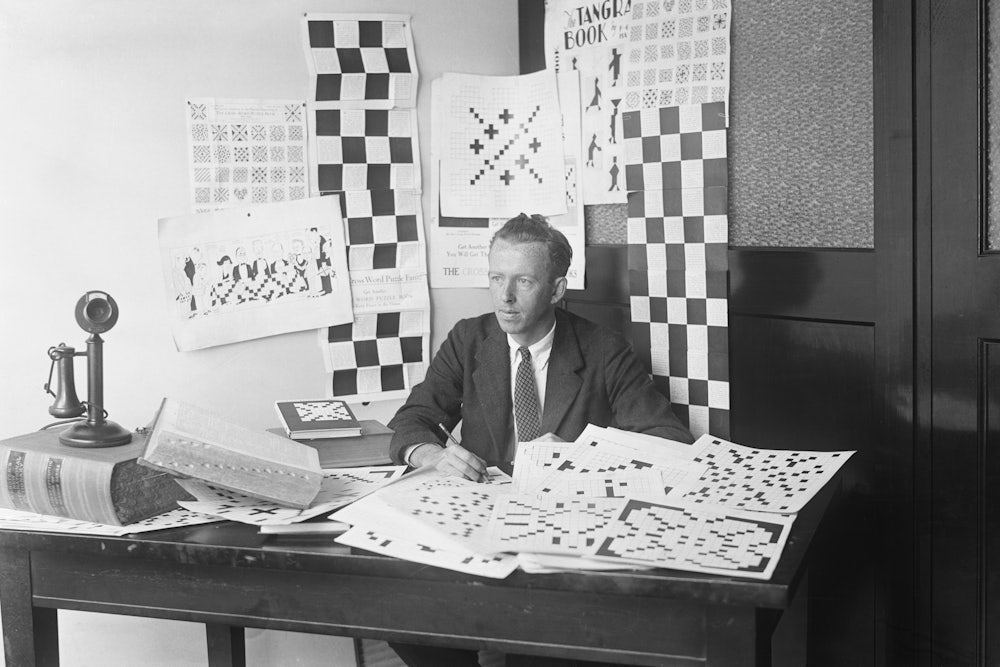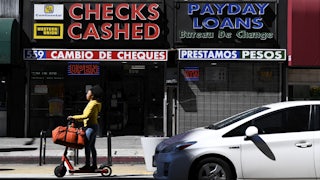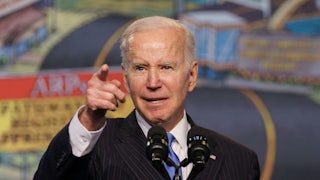The conspiracy theory writes itself. Start looking, and you’ll notice how many New York Times crossword puzzles are co-constructed (the preferred term for what most people would refer to as co-written) by a professional crossword constructor and someone with a day job—it’s hard not to see all the artists, web developers, professors, and other titles that imply a degree of wealth and elite connections. As the pandemic handed the work-from-home class extra time for their hobbies, the number of first-timers published in the Times has skyrocketed. Obviously, rich people are paying others to get the glory of their name in ink.
But the theory is almost diametrically wrong. It turns out the crossword industry really does consist of earnest wordplay lovers donating their time to unpaid mentorships, generally as part of an industry-wide effort to bring new and underrepresented people into crosswords.
Unfortunately, the end result might be even more exclusive than a pay-to-play scheme. And a game that brings the Times at least one million monthly subscribers—at $1.25 a week or $40 for a year—provides a sustainable living wage for shockingly few people.
Aimee Lucido offers a good example. The “crossword constructor and children’s author,” as described by the Times’ lead puzzle editor, Will Shortz, in the brief bio accompanying her most recent Sunday puzzle, got into constructing crosswords while she was a student at Brown University. “There were enough people at Brown who were associated with the New York Times crossword puzzle in various ways,” Lucido said—she got to know two former Shortz interns, three published constructors, and some competitive crossword solvers during her time in Providence—“that we decided we would see if we could do a Brown puzzle week in The New York Times.”
They succeeded in Lucido’s sophomore year, back in 2010. The series included Lucido’s first published puzzle, created with guidance from her college friends. Lucido has since published 12 more Times crosswords, in addition to having a standing gig at The New Yorker.
Hoping to pay the help she received forward to a new generation, Lucido decided to mentor new constructors at the beginning of the pandemic. With the George Floyd protests front of mind, she specifically sought out mentees from underrepresented backgrounds, eventually selecting three Black constructors, two of whom were women. But none of the mentorships panned out. Her mentees all dropped off, saying they didn’t have time for puzzles. “The less formal, more happenstance things tend to be more natural and last longer and work better, I guess, for me,” Lucido said.
One of those happenstance mentorships was with Ella Dershowitz. They met through a high school friend of the actress—and, yes, daughter of infamous lawyer Alan—who attended Brown with Lucido. Lucido and Dershowitz have been collaborating since early in the pandemic, publishing four Times puzzles together in the past two years, including Lucido’s last Sunday puzzle.
“Forced, professional relationships just don’t last, whereas Ella is a friend of mine, and [collaborating] serves multiple purposes,” Lucido said, while noting that she would still answer emails from her lapsed mentees to offer advice.
For would-be constructors without such personal connections, there’s the Crossword Puzzle Collaboration Directory. The Facebook group launched in 2018 with an associated Google form that pairs newcomers with mentors. It has always been explicit about its aims to provide resources to underrepresented groups: “This matching form is intended specifically for [women, people of color, LGBTQIA+ people, and disabled people] as a tool for addressing structural inequities in the crossword industry. Because our mentors’ time is finite, if you’re not a member of any such group, we ask that you refrain from using the form.”
The explicit intentions aren’t enough, though, and in fact at times the group has served the opposite purpose. When professional opera singer Daniel Okulitch, a white man, was inspired to try his hand at crossword construction after he first started regularly solving them during the pandemic, he found his way to the group. In response to a question he posted, Okulitch was contacted by Brad Wilber, a longtime constructor (60 Times puzzles since 2005) and an opera fanatic. A fan of Okulitch’s singing, Wilber offered his services as a mentor. Okulitch has now published three Times puzzles, including two with solo bylines.
Such stories are indicative of the Facebook group’s ambivalent impact, says Erik Agard, the crossword editor of USA Today and one of the directory’s co-founders. On the one hand, he says, “I’ve seen a lot of people who have participated in it go on to have puzzles in a variety of places and shout it out, which is exciting and gratifying. I personally have made connections to great newer constructors through there.”
The success stems from just how excited crossword fanatics are to evangelize and from their genuine efforts at diversifying the scene in recent years. Amateurs consistently speak to the kind, welcoming nature of the community. “I was sending [Wilber] incredible garbage to look at because I had no idea what I was doing,” Okulitch said of his early attempts. “His patience was astonishing.”
Even Agard, a biracial 28-year-old who has been written about as a crossword savant since he was a teenager and is now regarded as the leader of the “crossword revolution” for a more diverse industry, says he got his start through mentors he “cold-called out of the blue.”
However, there are deeper structural problems in the crossword industry.
The remarkably extensive data tracked by XWord Info, a website for crossword enthusiasts, outlines much of it: The number of Times debutants nearly tripled from 32 in 2019 to 92 last year. It’s on pace for around 90 this year. Other XWord Info data shows that women only accounted for 13 to 19 percent of Times puzzles in the 2010s, though interestingly that rate was often better for the prestigious (and better paid) Sunday puzzle than the year as a whole. Around 30 percent of puzzles over the past two years had a woman constructor.
Yet what gains there have been in diversity are largely contained to white women and white gay men, Agard says. Even a directory thread about a diverse crossword fellowship was dominated by white people, Agard added. The trend has been especially clear since Covid-19 handed those groups lots of free time and few ways to spend it.
“To the extent that people not from underrepresented groups are coming and using the resources of the group to further their constructing careers, it’s not really addressing gaps,” Agard says. The fact that there is no XWord Info data for race confirms his point, and class typically goes unmentioned altogether when constructors talk about diversifying crosswords. It’s not even mentioned as an area of underrepresentation in the Crossword Puzzle Collaboration Directory.
At core, the problem is that amateur constructors need mentors at all. While there aren’t many financial barriers to becoming a crossword constructor—the only real needs are a dictionary and puzzle-making software, and free options exist for both—the world is full of opaque, unstated conventions that double as barricades against the uninitiated, turning those already involved into gatekeepers, whether they want to be or not.
Editors obviously have the most direct role in enforcing crossword rules and norms. Some rules—such as the fact that plural clues have plural answers—are definitional to the game itself, though often unclear to new solvers. But others, like what makes a good theme or how obscure an answer can be, are far more subjective. To some extent, that difficulty is inherent in any word game: The difference between too easy, pleasantly challenging, and elitist is always a judgment call. But given the demographics at play, those judgments are made by certain people with certain assumptions.
But it’s not just editors. Agard mentions the “mostly white” constructors in the Crossword Puzzle Collaboration Directory—a space “ostensibly devoted to being supportive” of minority constructors—who shut down a Latino constructor’s idea for a chopped cheese–themed puzzle as a “nonstarter.” In acting as mentors, established constructors reinforce the assumption that, say, pretty much any dead baseball player or Latin phrase is fair game while references specific to minority cultures are out of bounds.
The worst possibility is that they are right, and a puzzle built around New York bodega staples would be rejected out of hand by editors and solvers both. It’s that structure of the crossword industry that makes it feel so unwelcoming to Portia Lundie, a filmmaker and constructor who wrote about the experience of being a Black woman in crosswords earlier this year.
Growing up in the Bronx while attending an elite, predominantly white school on the Upper East Side, Lundie still didn’t pick up on the specific kinds of knowledge needed to solve crosswords until a dedicated solver of a boyfriend taught her. “So much is just like people gatekeeping the background of how all of it comes together, because it makes you feel like you’re part of this prodigy group of people who should be admired,” Lundie says, noting that the biggest factor in whether a person makes it as a constructor (or solver, for that matter) is whether they have leisure time. “You need to have time on your hands to sit there,” Lundie says.
The old boy’s club nature becomes apparent when you try to define what makes someone a professional. “I think that term is interesting, because anybody who is getting published in the Times is getting paid for their work, and I would argue that makes you a professional puzzle maker,” says Matthew Stock, an employee at an educational nonprofit who has published almost 60 puzzles at various outlets in the past year—and yet was not a professional, according to his Shortz-authored Times bios. “The Times, it seems, reserves that professional puzzle-maker title for people whose primary source of income is puzzles.”
But even prominent constructors deemed professionals by Shortz fail that criterion, not to mention the bulk of constructors. Lucido notes that her husband’s stable career gives her the flexibility to make puzzles. Jeff Chen, the editor of XWord Info with over 130 Times puzzles to his name, told me he “had good fortune in previous careers,” by which he means he helped a friend start a pharmaceutical company that eventually went public. And Ross Trudeau, an occasional moderator of the Crossword Puzzle Collaboration Directory and constructor of over 50 Times puzzles, is the son of Doonesbury creator Garry Trudeau.*
Indeed, crosswords are something like a hobby you get paid for. “It’s definitely not what I think of when people ask me what I do for a living, but it is without a doubt a thing I do for a living,” Lucido says.
“I don’t see any particularly easy solutions to the problem,” says Will Nediger, another co-founder of the Crossword Puzzle Collaboration Directory and one of the maybe 20 people in the world, according to his estimate, who actually make a living from constructing crossword puzzles. “You’re limited by the size of the economy.”
Since a daily crossword like the Times’ gets hundreds of submissions per week for 365 openings a year, Nediger explains, simple laws of supply and demand mean it’s just not possible for crossword constructing to be a dependable income stream for most people. The pay is decent—$750 at the Times for a weekday puzzle for regular contributors (a constructor’s first two puzzles are paid at a lower rate) and more for Sundays—and constructors variously estimate that it only takes somewhere between half a day and a week or two to make a puzzle. But submissions are such a crapshoot it doesn’t matter, especially because the Times limits constructors to three submissions under consideration at any one time, while taking months to respond to each one. (That’s when it’s accepting submissions at all: It recently closed submissions for a month to let the editors “whittle down our backlog of mail.”) Trudeau published more Times puzzles than anyone in 2021, but that was only 11 overall, and seven of those were collaborations. If he split the payment for the collaborations equally, that puts his annual Times earnings at $7,125, at most.
“Even if The New York Times tripled their pay, which they could, quite easily,” says Nediger, “it wouldn’t really help significantly more people make a living, because it’s still 365 crosswords a year.” Most publications don’t pay nearly as well as the Times, either. The New Yorker is on par, at $750 per puzzle, according to Lucido, but crossword-specific outlets like the Crosswords With Friends app and AVCX pay around $350 or $400. Agard says USA Today only pays $100.
On top of that, constructors told me that most of them aren’t in it for the money. The job is done predominantly for the love of wordplay by those with leisure time to spare; the pay is just a bonus. Getting into the Times is like performing at the Met for singers, Okulitch says: “There’s a certain cachet attached to it.” It just doesn’t pay nearly as well.
But there are other benefits in the social circles where crosswords have clout. “If you do it as a hobby and you’re getting published in these major publications, that’s obviously going to bring you job opportunities,” Lundie says, claiming her own crosswords “of course helped me get more recognition and more jobs.”
That fact shapes the specifics of the resultant mentorships too. One of Nediger’s collaborators never even bothered to learn how to fill puzzles completely: She would develop themes, and Nediger handled the rest of the answers, then they’d write the clues together.
Meanwhile, the Times is making games an increasingly central part of its business model. The growth of its puzzles section has led to a diversification away from the standard 15 x 15 crossword—the size of the typical weekday puzzle, compared to the larger Sunday—and into other games, including new puzzles like Wordle and smaller crosswords. And those less prestigious arenas might be where the growth comes from for those who are trying to make a living.
Lundie says she depended on selling “packs” of 9 x 9 crossword puzzles at one point, though she didn’t gain recognition from the crossword fanatics until she published her first 15 x 15. And Nediger sees a future for crossword ads—both ones he’s been commissioned to make by various companies, for which he can charge more, and as a more interactive version of the digital ads filling most websites. He says it could be a way to boost time-on-site numbers for media websites looking to survive in the attention economy. It’s something like the crossword equivalent of what copywriting is for authors.
But none of this seems likely to scale while the crossword economy still functions on pro bono mentorships. Those relationships are simultaneously the exemplar of the communal ethos that makes crosswords a pleasantly niche pastime and an outdated patronage system that undermines efforts to diversify. The beloved puzzles are trapped in a contradiction at the heart of a faltering media economy.
As it turns out, some problems are so deeply embedded they don’t need conspirators: In the wrong conditions, thousands of kindhearted word lovers will do.
“The puzzles, particularly the ones that are most in the public eye—which are The New York Times and then, long pause, whatever the second one is—need to be more reflective,” Agard says. “And I do not think it would hurt if the rates were less low.”
* This article originally misstated Ross Trudeau’s role with the Crossword Puzzle Collaboration Directory.


